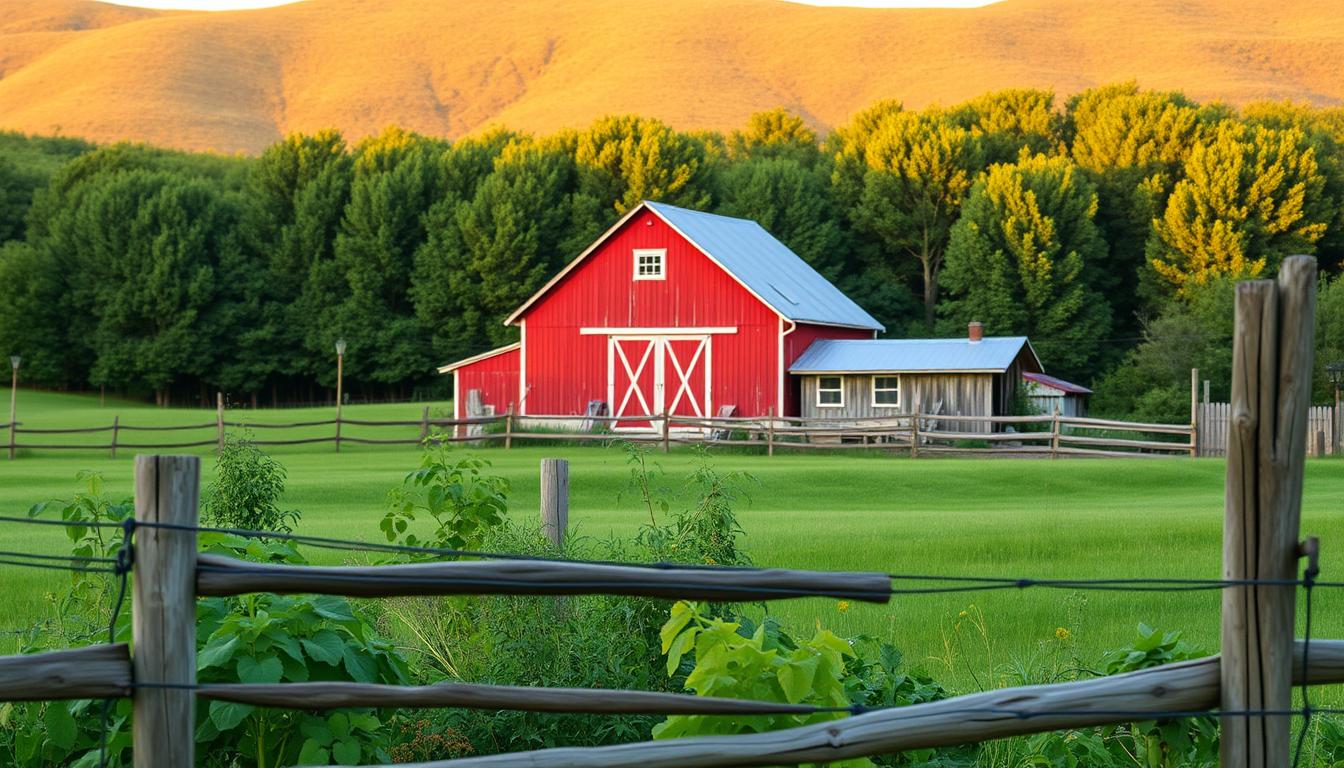Homesteading has seen a 200% surge in popularity over the last two years, with 72% of modern homesteaders beginning their journey in urban areas. This lifestyle offers a unique blend of self-sufficiency, sustainability, and connection to nature. Whether you’re looking to grow your own food, reduce costs, or improve mental health, homesteading can transform your life and help you achieve your goals.
Many beginners start small, with 63% opting for container gardens. Surprisingly, 89% of homesteaders report improved mental health, while USDA data shows a 40% cost savings on produce for home growers. Additionally, 58% of modern homesteads incorporate renewable energy systems, making this lifestyle both eco-friendly and economical.
Key Takeaways
- Homesteading interest has grown by 21% annually since 2020.
- Most beginners start with container gardens.
- Improved mental health is a common benefit.
- Home growers save up to 40% on produce costs.
- Renewable energy systems are used in over half of modern homesteads.
What Is Homesteading and Why Start Now?
Modern homesteading is a journey toward self-reliance and sustainability. It’s a customizable lifestyle that allows you to take control of your food, resources, and daily life. Whether you live in the city or the countryside, homesteading adapts to your space and goals.
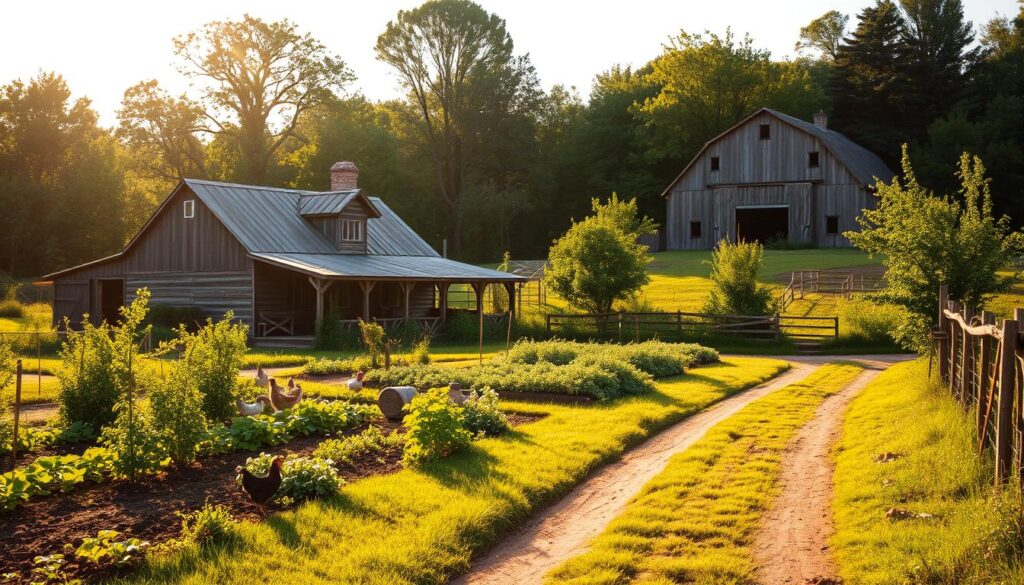
Understanding the Homesteading Lifestyle
At its core, homesteading is about controlled self-reliance. It’s not just about growing your own food but also reducing waste, conserving energy, and living sustainably. For example, an urban family in Chicago produces 40% of their vegetables on just 1/10 of an acre, proving that space isn’t a barrier.
John Jeavons, a pioneer in biointensive gardening, has shown that small-scale farming can yield up to four times more food than traditional methods. This makes homesteading a practical choice for those looking to enhance their food security.
Benefits of Starting a Homestead
Homesteading offers numerous advantages that go beyond just growing your own food. Here are seven core benefits:
- Reduce grocery bills by up to 30%.
- Lower your carbon footprint by 50%.
- Improve mental health through hands-on activities.
- Enhance food security by producing your own meals.
- Create a healthier, chemical-free diet.
- Build stronger family bonds through shared tasks.
- Contribute to environmental sustainability.
Your location plays a key role in what you can grow. Below is a table showing USDA Zone-specific production potential:
| USDA Zone | Recommended Crops |
|---|---|
| Zone 3-5 | Carrots, potatoes, kale |
| Zone 6-8 | Tomatoes, peppers, beans |
| Zone 9-11 | Citrus fruits, avocados, herbs |
With these benefits and resources, homesteading is more accessible than ever. It’s a sustainable lifestyle that empowers you to live intentionally and make a positive impact on the planet.
Define Your Homesteading Vision
Creating a homestead begins with a clear vision of what you want to achieve. This vision will guide your decisions, from the type of land you choose to the crops you grow. It’s essential to think about your family’s needs, your available time, and your budget to ensure your plans are realistic and sustainable.
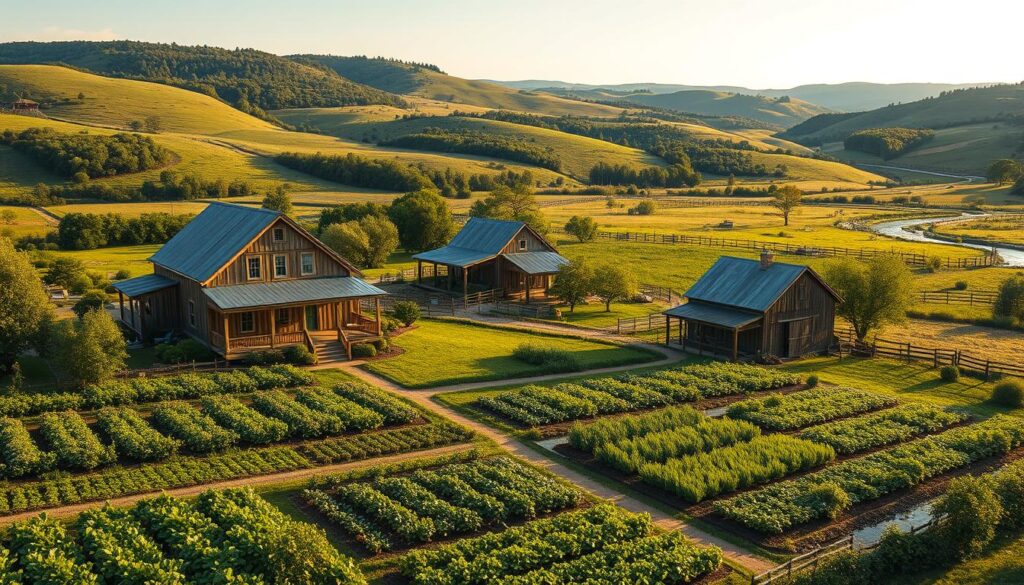
Ask Yourself Key Questions
Start by asking yourself a few key questions to shape your vision. What do you want to produce—vegetables, fruits, or livestock? How much money are you willing to invest? What role will your family play in daily tasks? These questions will help you create a roadmap tailored to your unique situation.
Consider using a 12-point vision checklist to cover all bases. This checklist includes:
- Types of livestock (chickens, goats, etc.)
- Energy systems (solar, wind, etc.)
- Food preservation methods (canning, freezing)
- Water sources (wells, rainwater collection)
- Long-term sustainability goals
Set Realistic Goals
Once you’ve defined your vision, it’s time to set goals. Use the SMART framework—Specific, Measurable, Achievable, Relevant, and Time-bound. For example, instead of saying, “I want to grow vegetables,” set a goal like, “I will plant and harvest 10 tomato plants by August.”
Referencing Eliot Coleman’s four-season harvest timelines can help you plan your planting and harvesting schedules. Additionally, USDA food preservation safety guidelines ensure your stored food remains safe and nutritious.
Avoid common first-year mistakes, such as overplanting herbs (87% of beginners do this). Start small, focus on a few crops or animals, and expand as you gain experience. This approach saves time, money, and effort while reducing stress.
Assess Your Current Situation
Before diving into homesteading, it’s crucial to evaluate your current setup. Understanding your skills, available space, and resources ensures a smooth transition. This step helps you identify what you already have and what you need to acquire.
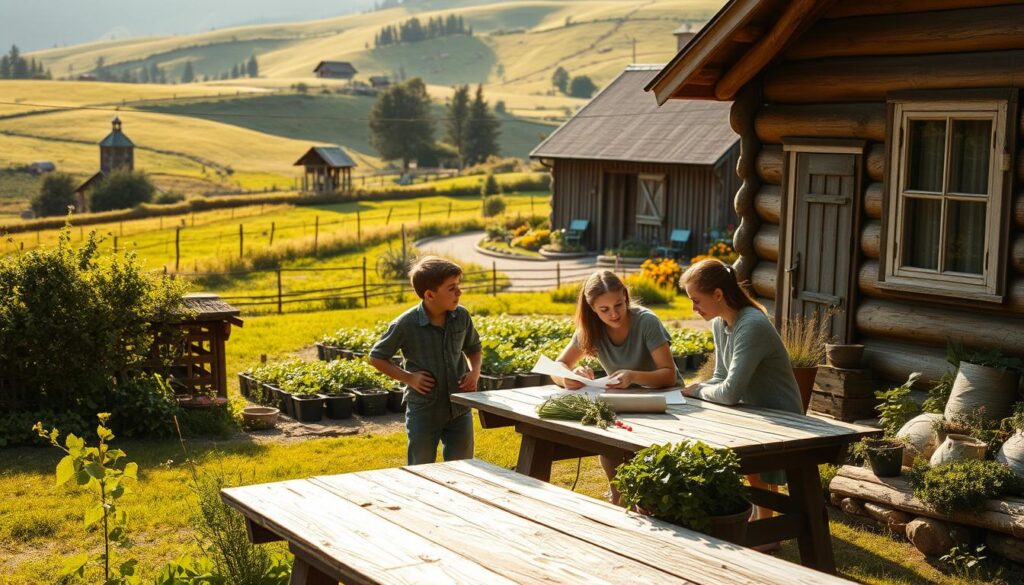
Evaluate Your Skills and Resources
Begin by assessing your skills and available equipment. Use a skills matrix to rate yourself on essential tasks like gardening, composting, and basic repairs. For example, urban composting solutions can save up to 300 lbs of waste annually, making it a valuable skill to master.
Consider the following tools to evaluate your readiness:
- Skills assessment matrix (rate 1-5 for 20 essential skills).
- Space utilization calculator for different property sizes.
- NRCS soil testing protocol to analyze your land’s potential.
Consider Your Living Space
Your property and space play a significant role in homesteading. Even small areas can be productive. For instance, one apartment homestead produces 15 lbs of microgreens monthly using vertical gardening techniques.
Analyze your space with these methods:
- Solar exposure analysis using mobile apps to determine sunlight availability.
- Case studies of successful small-scale homesteads for inspiration.
By evaluating your current situation, you’ll gain clarity on how to move forward. This step ensures you’re prepared to make the most of your access to resources and land.
Research Local Zoning Laws and Permits
Understanding local zoning laws is essential for a successful homesteading journey. These laws dictate what you can and cannot do on your property, from raising livestock to building structures. Ignoring them can lead to fines or even legal action.

Understanding Property Restrictions
Before you begin, research your area’s regulations. Some zones may prohibit certain activities, like keeping chickens or goats. Others may limit the size of structures or require specific setbacks from property lines.
Here are key considerations:
- Check a 50-state comparison of backyard chicken laws.
- Review water rights documentation requirements.
- Understand home occupation license exceptions for farm stands.
Navigating Legal Requirements
Obtaining the right permits ensures compliance with local laws. Use a step-by-step flowchart to simplify the process. The USDA cooperative extension office can also provide valuable guidance.
Key steps include:
- Consulting a land purchase checklist with 18 legal considerations.
- Utilizing USDA resources for property-specific advice.
- Ensuring all permits are in place before starting projects.
By addressing these legal aspects early, you can avoid costly mistakes and focus on building your dream homestead.
Start Small: Homesteading in Limited Spaces
Limited space doesn’t mean limited potential when it comes to homesteading. Even in small spaces, you can grow food, raise animals, and live sustainably. Whether you’re in an apartment or a tiny backyard, these tips will help you make the most of what you have.
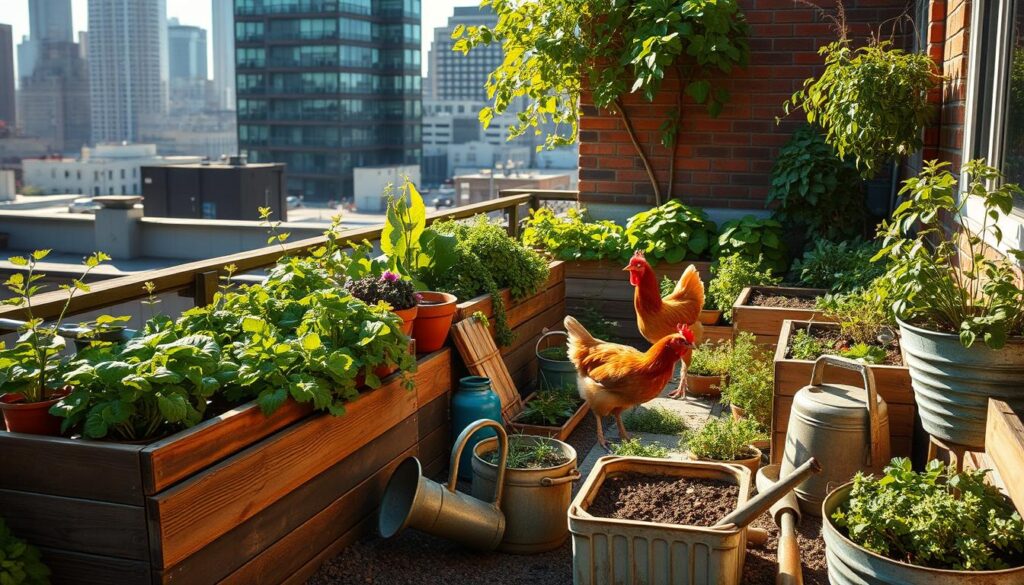
Urban Homesteading Tips
Living in the city doesn’t stop you from embracing urban homesteading. Start by maximizing vertical space with trellises or shelves. Herbs, lettuce, and strawberries thrive in small pots or hanging planters. Use window sills for year-round herbs with proper insulation techniques.
Consider aquaponics systems for a compact way to grow fish and plants together. These systems are efficient and can fit in tight corners. For livestock, rabbits are a great option. They require minimal space and provide a quick return on investment.
Container Gardening and Small Livestock
Container gardening is perfect for small spaces. Use grow bags, pots, or even repurposed containers. Patio potato grow bags, for example, can yield up to 10 lbs per square foot. Other space-efficient crops include mushrooms, dwarf fruit trees, and microgreens.
For those interested in micro-livestock, chickens are a popular choice. Mobile chicken tractors under 25 sqft allow them to graze safely while fertilizing your garden. Ducks and quails are also excellent options for urban settings.
Here are some quick tips to get started:
- Choose 15 space-efficient crops, from mushrooms to dwarf fruit trees.
- Use a rabbitry ROI calculator to assess profitability.
- Explore vertical farming techniques to maximize space.
- Insulate windows to grow herbs year-round.
- Design mobile chicken tractors for small backyards.
With these strategies, you can turn even the tiniest space into a productive homestead. It’s all about creativity and making the most of what you have.
Learn Essential Homesteading Skills
Mastering essential skills is the foundation of a successful homesteading journey. Whether you’re growing food or raising animals, these abilities ensure your efforts are sustainable and rewarding. Let’s explore the basics of gardening and animal care to help you get started.
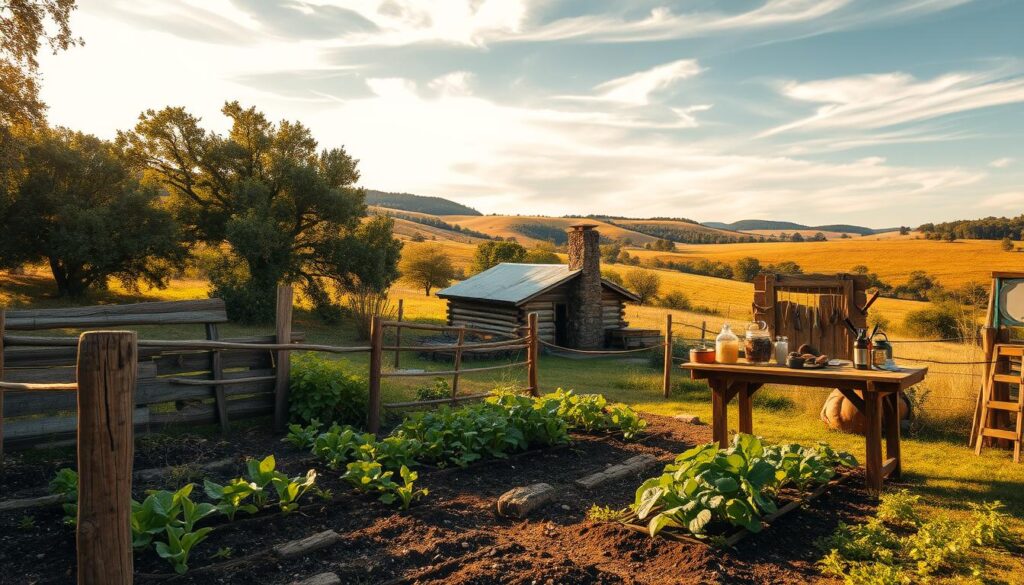
Gardening Basics
Successful gardening begins with understanding your soil. Test your soil’s pH and nutrient levels to determine what amendments it needs. Healthy soil leads to a bountiful harvest.
Start with an 8-week seed starting program to master the basics. Use companion planting charts to naturally control pests and improve crop yields. For example, planting marigolds with tomatoes can deter harmful insects.
Here’s a quick guide to essential gardening tools:
- Soil testing kit for accurate analysis.
- Compost bin for organic fertilizer.
- Rainwater collection system for sustainable watering.
Animal Care and Raising Livestock
Raising animals requires knowledge of their needs and behaviors. Use a 5-point welfare assessment to ensure your animals are healthy and happy. This includes checking their diet, shelter, and social interactions.
Be prepared for emergencies with a veterinary care protocol. For instance, knowing how to manage a chicken health crisis can save lives. Keep a first-aid kit stocked with essentials like bandages and antiseptics.
Here’s a table comparing common livestock options:
| Animal | Space Needed | Maintenance Level |
|---|---|---|
| Chickens | Small | Low |
| Goats | Medium | Moderate |
| Rabbits | Minimal | Low |
“The key to successful homesteading is learning by doing. Start small, stay consistent, and grow your skills over time.”
By focusing on these essential skills, you’ll build a strong foundation for your homesteading journey. Whether it’s nurturing your garden or caring for animals, every step brings you closer to self-reliance.
Create a Budget for Your Homestead
Financial planning is a cornerstone of any successful homesteading journey. A well-thought-out budget ensures you allocate resources wisely and avoid unnecessary expenses. Whether you’re starting small or planning a full-scale setup, understanding your financial needs is crucial.

Prioritize Expenses
Begin by listing your essential expenses. These might include land, tools, seeds, and livestock. Use a startup cost breakdown to guide your spending. For example, a micro setup can cost as little as $500, while a full-scale homestead may require up to $50,000.
Here’s a quick guide to prioritize your spending:
- Invest in high-ROI items like seeds and basic tools.
- Allocate funds for long-term assets such as solar panels or water systems.
- Set aside an emergency fund using calculation formulas.
Find Ways to Save Money
Homesteading doesn’t have to break the bank. Explore cost-saving strategies to stretch your budget. Creative funding sources like CSA prepayments or agricultural grants can provide financial support.
Consider these money-saving tips:
- Implement a barter system to exchange goods and services.
- Use equipment depreciation schedules to plan replacements.
- Grow high-yield crops to maximize your ROI.
By focusing on financial planning, you can build a sustainable homestead without overspending. Every dollar saved brings you closer to self-reliance.
Find the Perfect Property for Your Homestead
Finding the right property is a critical step in building your dream homestead. The land you choose will shape your ability to grow food, raise animals, and live sustainably. Whether you’re looking for a small plot or expansive acreage, understanding your needs is essential.
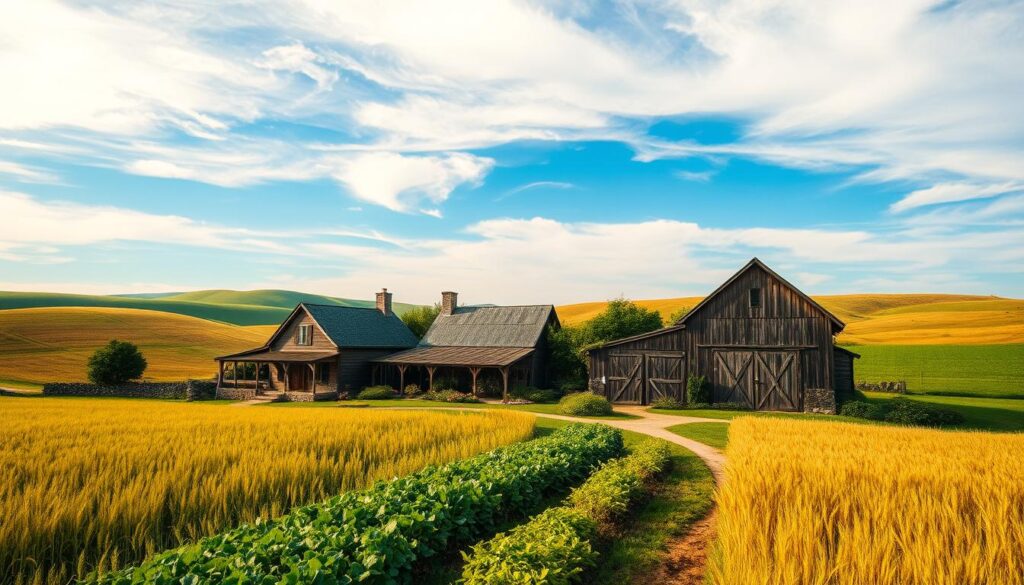
Determine Your Land Needs
Start by evaluating what you want to achieve with your homestead. Consider the size of your family, the types of crops or animals you plan to raise, and your long-term goals. A 15-point land evaluation checklist can help you assess factors like soil quality, water availability, and zoning restrictions.
For example, a perc test interpretation guide ensures your property is suitable for septic systems. Contour mapping can prevent flooding by identifying low-lying areas. These tools help you make informed decisions and avoid costly mistakes.
Tips for Buying Land
When purchasing land, research is key. Look for red flags during a title search, such as liens or unresolved disputes. Easement negotiation tactics can protect your access to essential resources like roads or water sources.
Here are some practical tips to consider:
- Use a land-sharing strategy to reduce costs by up to 40%.
- Invest in soil testing to ensure fertility.
- Verify water rights to secure access for irrigation.
- Check local zoning laws for restrictions on livestock or structures.
- Plan for future expansion by choosing a property with extra acreage.
By following these steps, you can find the perfect land for your homestead. Taking the time to evaluate and research ensures your investment supports your vision for a sustainable, self-reliant lifestyle.
Plan Your Homestead Layout
Planning your homestead layout is the first step toward creating a functional and sustainable space. A well-thought-out design ensures efficiency, productivity, and room for growth. Whether you’re working with a small plot or expansive acreage, your layout will shape your daily life and long-term success.

Designing Functional Spaces
Start by dividing your property into zones based on their purpose. For example, place your garden close to your home for easy access, while livestock areas can be farther away. Use permaculture principles to create a harmonious flow between these zones.
Consider these strategies for functional design:
- Use permaculture sector analysis templates to identify sun, wind, and water patterns.
- Plan livestock rotation patterns to maintain soil health and prevent overgrazing.
- Design emergency access routes for safety during unexpected events.
Considering Future Expansion
Your homestead should be designed with scalability in mind. Think about how your needs might change over time and leave room for growth. For example, you might start with a small garden but plan for additional planting areas in the future.
Here’s a table to help you plan for expansion:
| Feature | Initial Setup | Future Expansion |
|---|---|---|
| Garden | Raised beds | Additional plots |
| Livestock | Chickens | Goats or cows |
| Infrastructure | Small shed | Barn or workshop |
By incorporating these strategies, you’ll create a homestead that’s both functional and adaptable. Thoughtful planning ensures your space evolves with your needs, making your journey toward self-reliance smoother and more enjoyable.
Start Growing Your Own Food
Growing your own food is a rewarding step toward self-sufficiency. With a 90% edible landscape conversion rate, even small spaces can become productive gardens. The key lies in choosing the right crops and preparing your soil for optimal growth.
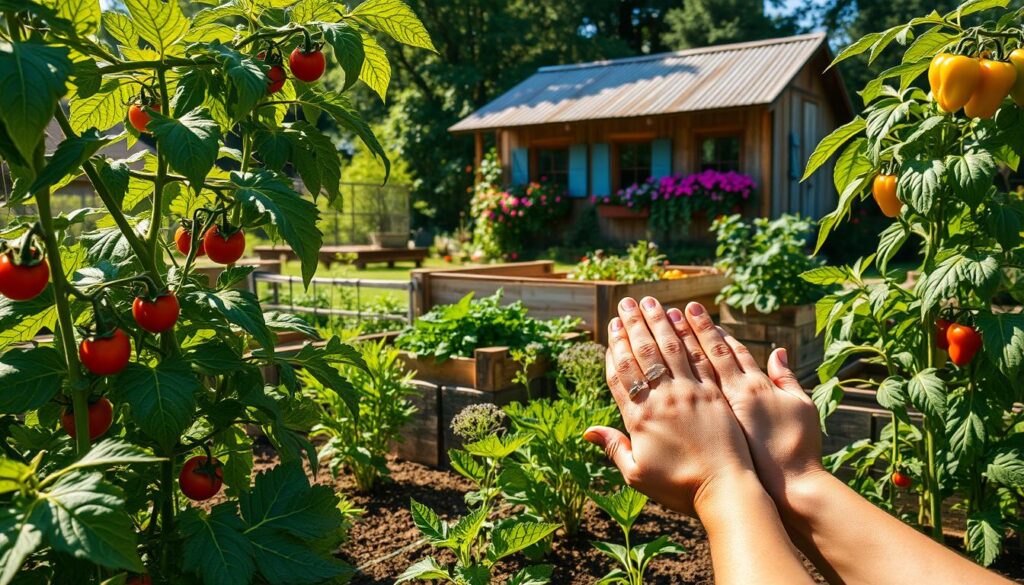
Choosing the Right Crops
Selecting the right crops ensures a bountiful harvest. Use a calorie-dense crop selection matrix to prioritize high-yield options like potatoes, beans, and squash. Consider heirloom varieties for their resilience and flavor, and compare them to GMO options for yield differences.
Succession planting calendars can help you maximize your garden’s potential. For example, planting lettuce in early spring and replacing it with tomatoes in summer keeps your space productive year-round. A food forest establishment timeline can also guide long-term planning for sustainable food sources.
Soil Preparation and Planting Tips
Healthy soil is the foundation of a thriving garden. Start by testing your soil’s pH and nutrient levels. Biochar production tutorials can show you how to enrich your soil naturally, improving its structure and fertility.
When planting, follow these tips for success:
- Use companion planting to deter pests and boost growth.
- Rotate crops annually to prevent nutrient depletion.
- Incorporate organic matter like compost to enhance soil health.
“The best gardens begin with healthy soil and thoughtful planning. Invest time in preparation, and your harvest will reward you.”
By focusing on the right crops and proper soil preparation, you’ll create a sustainable food source that supports your self-reliance goals. Whether you’re growing vegetables or establishing a food forest, every step brings you closer to a thriving edible landscape.
Raise Livestock for Self-Sufficiency
Raising livestock is a cornerstone of self-sufficiency, offering both food and resources. Whether you’re raising chickens for eggs or goats for milk, animals can transform your homestead into a thriving ecosystem. Proper care and planning ensure your animals stay healthy and productive.
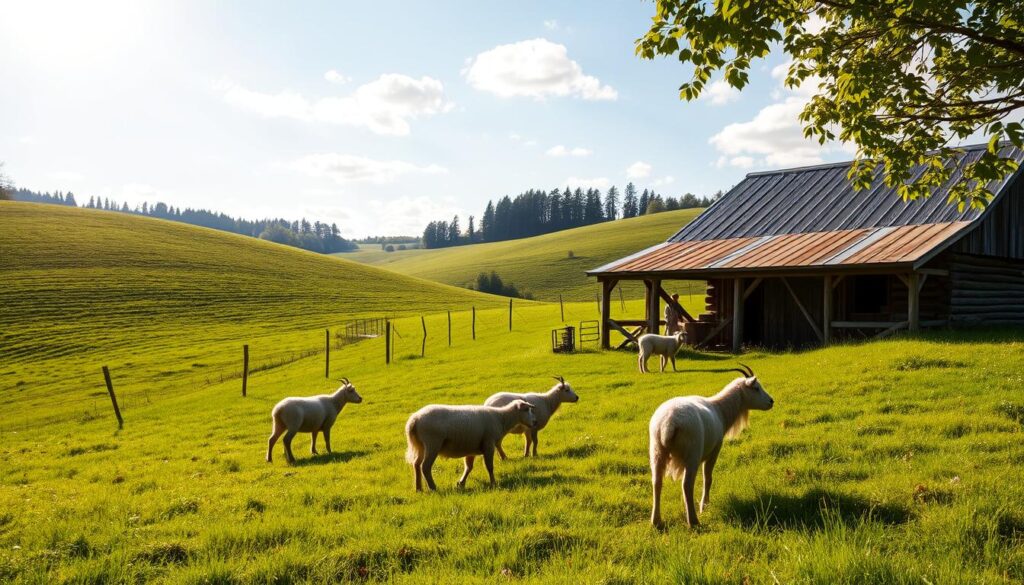
Starting with Chickens
Chickens are a popular choice for beginners. They provide fresh eggs and can even supply meat if needed. To keep your flock healthy, use a poultry mortality prevention checklist. This includes regular health checks, clean coops, and proper nutrition.
Rotational grazing density calculations can help you manage their space efficiently. Chickens thrive in environments where they can forage, reducing feed costs and improving their health. A well-maintained flock can produce up to 300 eggs per year per hen.
Expanding to Larger Animals
Once you’re comfortable with chickens, consider larger animals like goats or cows. These animals provide milk, meat, and even manure for composting. A milk production cost analysis can help you determine if dairy animals are a good fit for your homestead.
Butchering yield percentages by breed ensure you choose animals that meet your needs. For example, certain goat breeds offer higher meat yields, while others are better for milk. Proper care and feeding are essential for their health and productivity.
Manure management systems are another consideration. Livestock manure is a valuable fertilizer, but it must be managed correctly to avoid environmental issues. Composting or using it directly in your garden can enrich your soil naturally.
“Raising livestock is about more than just food—it’s about building a sustainable, self-reliant lifestyle.”
By starting small and expanding thoughtfully, you can create a thriving livestock system that supports your homesteading goals. Whether you’re raising chickens or larger animals, every step brings you closer to self-sufficiency.
Preserve Your Harvest
Preserving your harvest ensures you enjoy fresh, homegrown food year-round. Proper storage techniques like canning, freezing, and dehydration help you maximize your efforts and reduce waste. Whether you’re a beginner or an experienced gardener, these methods are essential for a sustainable lifestyle.
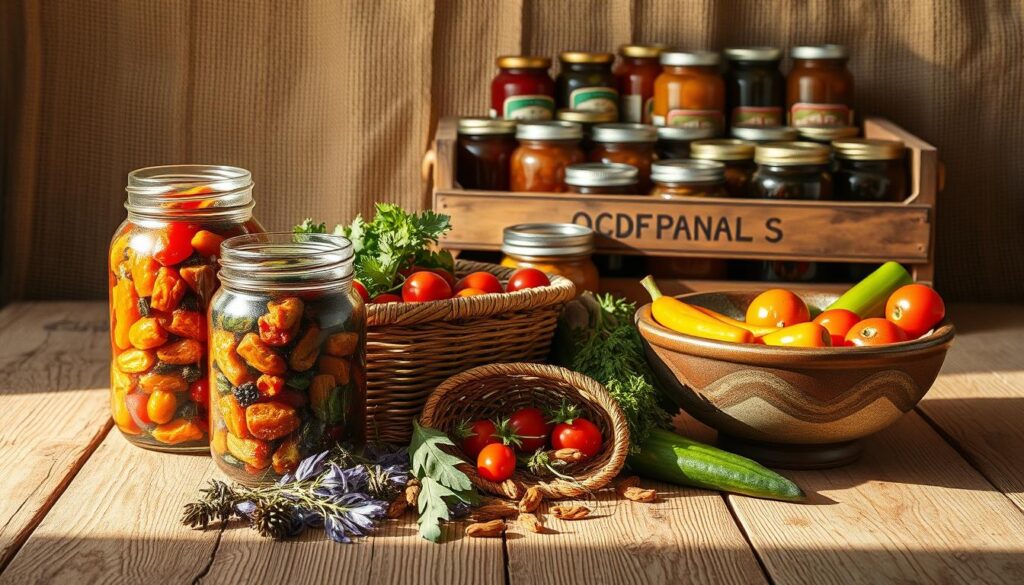
Canning and Freezing Techniques
Canning is a popular method for long-term storage. USDA-approved timelines ensure safety and quality. For example, high-acid foods like tomatoes require boiling water baths, while low-acid foods like beans need pressure canning. Always follow guidelines to prevent spoilage.
Freezing is another effective way to preserve your harvest. Use freezer inventory rotation systems to keep track of what you’ve stored. Blanching vegetables before freezing helps retain their color and nutrients. Label and date everything for easy access.
Other Food Preservation Methods
Root cellars are ideal for storing root vegetables like carrots and potatoes. Proper construction specs ensure consistent temperature and humidity. Lacto-fermentation is another option, with pH monitoring to ensure safety. This method is perfect for making sauerkraut or kimchi.
Solar dehydration is an eco-friendly way to preserve fruits and herbs. Efficiency rates vary based on sunlight and humidity levels. Use screens or trays to dry your produce evenly. Store dehydrated foods in airtight containers to maintain freshness.
| Method | Efficiency Rate |
|---|---|
| Canning | 90% |
| Freezing | 85% |
| Dehydration | 75% |
“Preserving your harvest is about more than just saving food—it’s about creating a sustainable, self-reliant lifestyle.”
By mastering these preservation techniques, you’ll ensure your hard work pays off year-round. For more tips on getting started, check out this guide on gardening for beginners.
Build a Homesteading Community
Building a strong community can amplify your self-sufficiency journey. Connecting with like-minded individuals not only provides support but also opens doors to shared resources and knowledge. Whether you’re new to homesteading or a seasoned pro, fostering relationships within your local or online community can make a significant difference.
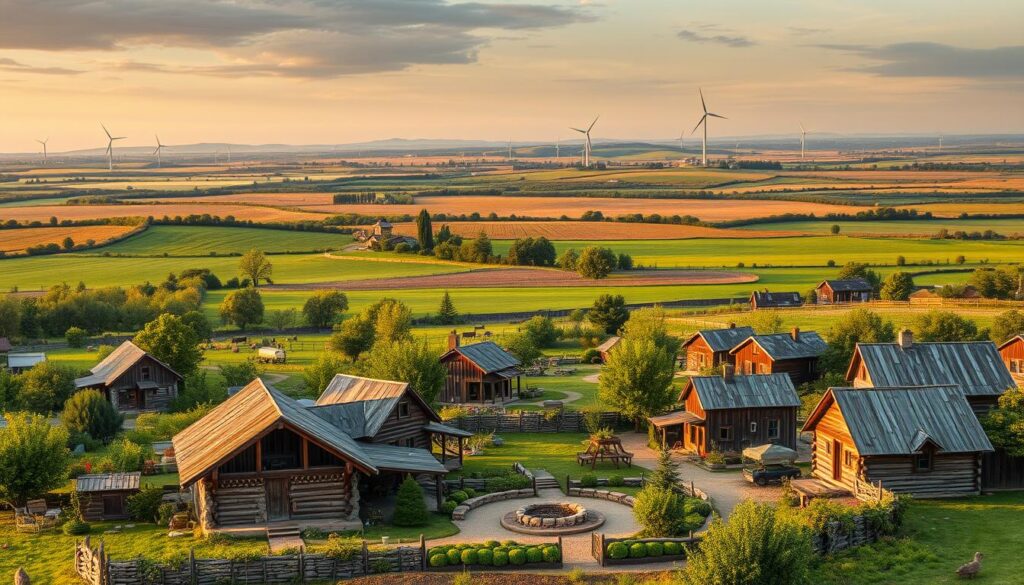
Connecting with Like-Minded People
Finding others who share your passion for homesteading is easier than you might think. Start by joining local gardening clubs, attending farmers’ markets, or participating in online forums. These platforms offer opportunities to exchange ideas, learn new skills, and build lasting relationships.
Consider using a 12-step community building framework to guide your efforts. This includes identifying common goals, organizing meetups, and creating spaces for collaboration. Networking with others can lead to valuable partnerships, such as land-sharing agreements or equipment co-ops.
Sharing Resources and Knowledge
One of the greatest benefits of a homesteading community is the ability to share resources. From tools to seeds, pooling assets reduces costs and increases efficiency. A barter system can also be a game-changer, allowing you to trade goods or services without cash.
Here are some practical ways to share and grow together:
- Set up skill-share tracking spreadsheets to document expertise within the group.
- Use CSA marketing templates to promote collective farming efforts.
- Create emergency mutual aid agreements to support each other during tough times.
“Alone we can do so little; together we can do so much.”
By fostering a spirit of collaboration, you’ll not only enhance your homesteading experience but also contribute to a more sustainable and connected community. Sharing resources and knowledge ensures everyone thrives, making the journey more rewarding for all.
Prepare for Challenges
Facing challenges is an inevitable part of the homesteading journey. From unexpected crop failures to predator attacks, every homesteader encounters obstacles. The key to success lies in problem-solving and resilience. By preparing for these setbacks, you can turn them into opportunities for growth.
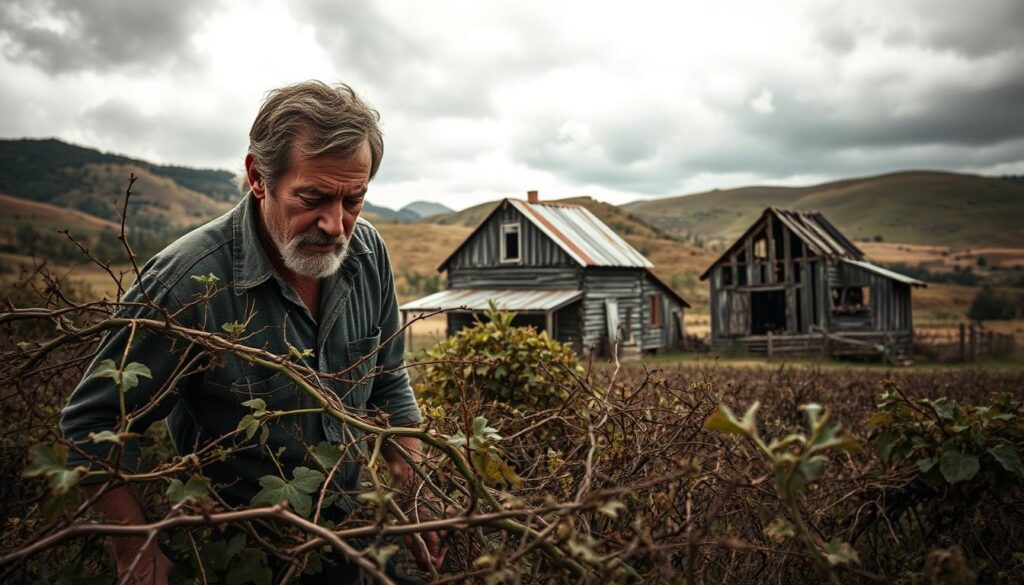
Dealing with Setbacks
Setbacks are a natural part of homesteading. For example, a chicken prolapse emergency can be stressful, but with proper care, your flock can recover. A case study showed that immediate action and preventive measures reduced mortality rates by 80%. This highlights the importance of being prepared for common challenges.
Here are some strategies to handle setbacks effectively:
- Create a disaster recovery fund using financial formulas.
- Install alternative energy backup systems for emergencies.
- Maintain detailed records to identify patterns and improve processes.
Staying Motivated
Staying motivated during tough times requires focus and adaptation. A mental health maintenance schedule can help you stay balanced. Include activities like gardening or meditation to reduce stress. Surround yourself with a supportive community to share experiences and solutions.
Here’s a quick guide to staying on track:
- Set small, achievable goals to maintain momentum.
- Celebrate successes, no matter how small.
- Learn from failures and adjust your approach.
“Every challenge is an opportunity to grow stronger and more resilient.”
By embracing challenges and focusing on problem-solving, you’ll build a sustainable and fulfilling homesteading lifestyle. Preparation and adaptation are your best tools for long-term success.
Start a Homestead Business (Optional)
Transforming your homestead into a profitable venture can open new doors to financial independence. Whether you’re looking to supplement your income or build a full-fledged business, there are numerous opportunities to explore. From selling niche products to offering agritourism experiences, your homestead can become a sustainable source of revenue.
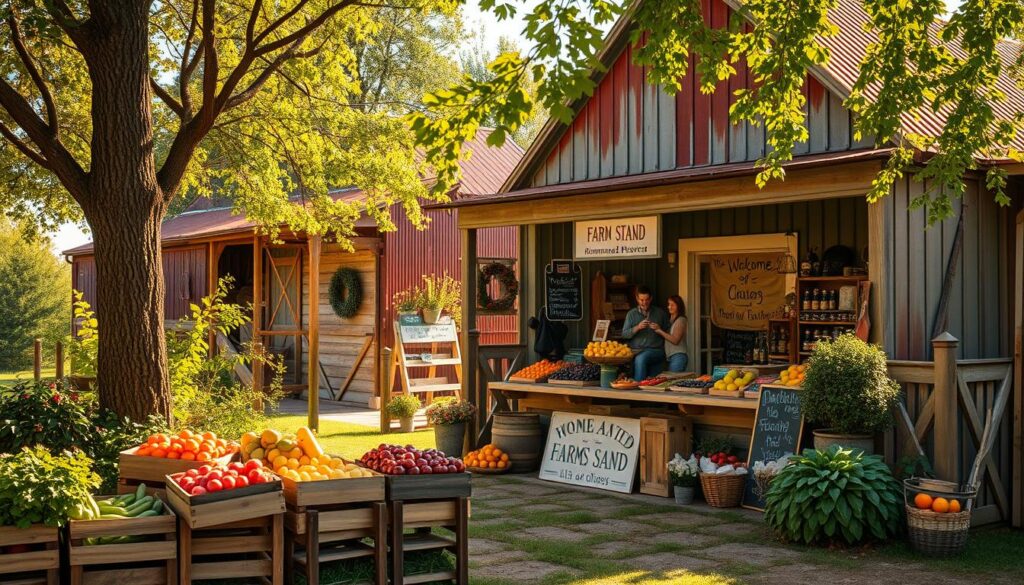
Turning Your Homestead into a Revenue Source
There are many ways to generate income from your homestead. Niche products like herbal salves, specialty mushrooms, or handmade soaps are in high demand. Farmers’ markets are a great place to start, and ROI calculators can help you estimate potential profits. Value-added products, such as jams or pickles, often fetch higher prices and require minimal investment.
Agritourism is another lucrative option. Offering farm stays, workshops, or seasonal events can attract visitors and boost your earnings. However, it’s essential to meet insurance requirements to protect your business and guests.
- Herbal salves and specialty mushrooms are profitable niche products.
- Farmers’ market ROI calculators help estimate earnings.
- Value-added products like jams increase revenue potential.
- Agritourism requires proper insurance and planning.
Legal and Financial Considerations
Starting a homestead business involves navigating legal and financial regulations. Forming an LLC can protect your personal assets and simplify tax filing. Cost comparisons for LLC formation can help you choose the best option for your needs. Licensing is also crucial for value-added products, ensuring compliance with local regulations.
Online sales are a growing trend, but they come with tax compliance requirements. A guide to online sales tax can help you stay on top of your obligations. Building a strong branding strategy is equally important. A recognizable brand can set you apart in a competitive market.
“A well-planned homestead business can turn your passion into profit while supporting a sustainable lifestyle.”
- LLC formation protects assets and simplifies taxes.
- Licensing ensures compliance for value-added products.
- Online sales tax compliance is essential for e-commerce.
- Effective branding builds customer loyalty.
Conclusion: Begin Your Homesteading Journey Today
Embarking on your homesteading journey is a powerful step toward self-reliance and sustainability. With 94% of homesteaders reporting improved life satisfaction, this lifestyle offers a meaningful transformation for those seeking empowerment and connection to nature.
To get started, use a 30-day launch plan checklist to organize your efforts. A resource directory with 50+ vetted suppliers ensures you have access to quality tools and materials. Seasonal planning calendars help you stay on track throughout the year.
Connecting with mentorship programs provides valuable guidance and support. A continuous learning roadmap keeps you inspired and informed as you grow your skills. Every step you take brings you closer to a more sustainable and fulfilling lifestyle.
Your homesteading journey is not just about growing food—it’s about creating a life of purpose and empowerment. Take the first step today and embrace the transformation that awaits.

